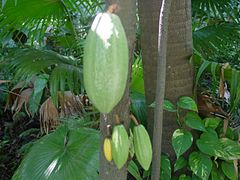The Cacao Craze
Monday, February 25, 2008Yesterday while housesitting for a friend, the wife and I finished off a hearty dinner. (For those both wondering and not wondering, I dropped culinary skillz to the tune of mussels in white-wine and garlic broth accompanied by a toasted baguette, fresh green beans in lemon-parsley butter and rosemary roasted potatoes. Fools better recognize.) While coming down from my mollusk-induced high, I opted for a piece of chocolate for dessert. I curiously noted the chocolate’s label: “65% Cacao”.
Trendspotting time, homes.
Chocolate companies are repping this cacao trend to the fullest. Take a look at some of the yuppie high-end chocolates next time you’re at the grocery store, and you’ll inevitably notice more percentage rates than a savings and loan.
 For those who aren’t Pennsylvanian — read “awesome” — and haven’t done Hershey’s Chocolate World (be warned that the link features loud and annoying music), the cacao tree — native to Mesoamerica and an important part of the Columbian exchange — produces the beans that are processed into cocoa and, subsequently, chocolate. If chocolate is steel, cacao is the iron ore. (I guess that means adding milk is the Bessemer process and Switzerland is the Monongahela Valley.)
For those who aren’t Pennsylvanian — read “awesome” — and haven’t done Hershey’s Chocolate World (be warned that the link features loud and annoying music), the cacao tree — native to Mesoamerica and an important part of the Columbian exchange — produces the beans that are processed into cocoa and, subsequently, chocolate. If chocolate is steel, cacao is the iron ore. (I guess that means adding milk is the Bessemer process and Switzerland is the Monongahela Valley.)
As a dude who likes to get his occasional chocolate on, I think I am qualified to state that good chocolate, like any good food, does not happen solely by cramming your product with as much of one ingredient as you can. It is instead about balance: cacao is one part, but how well do you balance it with sugar, milk and other ingredients? That is key.
The cacao-percentage thing then is sly marketing: a way for one chocolate company to artificially quantify that its product is better than the competitor. I don’t know if this strategy is native to the U.S. chocolate market, but it does seem like a peculiarly American way to advertise food. Add in the oft-discussed health benefits of dark chocolate — easily confused with its tastier milk-enhanced variant, and who doesn’t like to exaggerate the healthiness of something that tastes great? — and you have the perfect status-symbol storm.
I think most of us are smart enough not to buy chocolate based on it having some higher numerical value, but I’m sure there are people who do so. To those people, I say, yo: buy the best-tasting kind, because higher cacao != consistently awesome.
This chocolate, on the other hand, always == awesome.
milk chocolate is for commies. so of course you prefer it to the dark chocolate loved by true americans.
Your dinner sounds really good – I’d eat it. In SF everyone is a food snob and it is at the point where I will no longer admit to liking white chocolate (‘that’s not even REAL chocolate’), let alone milk chocolate. I’d bet a lot of them totally DO look just at those percentages and then claim to like that best. Suckas.
See, I’m not even a huge fan of chocolate. But, you mix that up wiht some nice peanut butter… mmmmmm.
Mr. Reese, I salute you.
I would like to note that milk chocolate is one of the Western world’s greatest achievements.
Dove chocolate is the bomb. Plus those British Flakes bars are killa too. I am more of a sour guy. Need my sweet-tarts.
The importance of the % of Cacao is important for tempering and working with chocolate. If youa re looking for a thin coat and a nice shine on your truffles you need a high percentage of Cacao (now i’m not sure if 1-5% difference is going to matter)